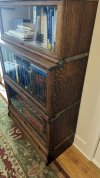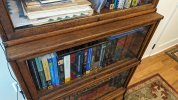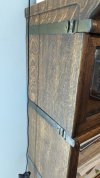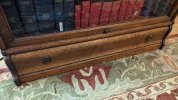This week I got my hands on a Globe-Wernicke barrister bookcase that was originally bought (used) by my grandparents in the 50s. Based on the information I've been able to find about it, it appears to have been made sometime prior to 1920. Beyond the sentimental value it's something I'd love to have in my office, so I'm motivated to restore it the right way.
I make some furniture, but I don't have any experience doing restoration like this. My father said that he and my mother refinished it about 40 years ago, and he thinks it was some kind of oil/varnish mixture, possibly a tung oil-based product. As you can see from the pictures, there's one very faded spot on the right side where it was intermittently exposed to direct sun in my parents' house.
I'm hoping that folks here can give me some guidance on making it turn out great. Some pictures are attached. I'm looking for thoughts on what product(s) to use and best practices for removing the brass banding around each section. Each of the shelves can be separated from the others and all of the brass banding is held on with small nails. There are a few missing, so I also need to figure out where to buy similar replacements and put a patina on them to match the others. I think I want to avoid using a typical nail puller so I don't mar the nails or the banding, but again, I don't know how the experts do it.
All thoughts are appreciated.
I make some furniture, but I don't have any experience doing restoration like this. My father said that he and my mother refinished it about 40 years ago, and he thinks it was some kind of oil/varnish mixture, possibly a tung oil-based product. As you can see from the pictures, there's one very faded spot on the right side where it was intermittently exposed to direct sun in my parents' house.
I'm hoping that folks here can give me some guidance on making it turn out great. Some pictures are attached. I'm looking for thoughts on what product(s) to use and best practices for removing the brass banding around each section. Each of the shelves can be separated from the others and all of the brass banding is held on with small nails. There are a few missing, so I also need to figure out where to buy similar replacements and put a patina on them to match the others. I think I want to avoid using a typical nail puller so I don't mar the nails or the banding, but again, I don't know how the experts do it.
All thoughts are appreciated.
Attachments
-
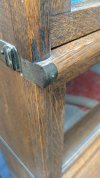 PXL_20220206_230912927.jpg1.7 MB · Views: 276
PXL_20220206_230912927.jpg1.7 MB · Views: 276 -
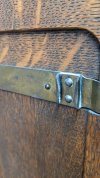 PXL_20220206_230853130.jpg2 MB · Views: 289
PXL_20220206_230853130.jpg2 MB · Views: 289 -
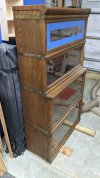 PXL_20220206_230518998.jpg2.2 MB · Views: 285
PXL_20220206_230518998.jpg2.2 MB · Views: 285 -
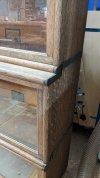 PXL_20220206_230544821.jpg1.8 MB · Views: 274
PXL_20220206_230544821.jpg1.8 MB · Views: 274 -
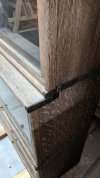 PXL_20220206_231130432.jpg2.2 MB · Views: 272
PXL_20220206_231130432.jpg2.2 MB · Views: 272 -
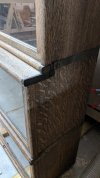 PXL_20220206_230536670.jpg1.7 MB · Views: 284
PXL_20220206_230536670.jpg1.7 MB · Views: 284 -
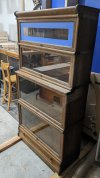 PXL_20220212_001820095.jpg1.8 MB · Views: 332
PXL_20220212_001820095.jpg1.8 MB · Views: 332 -
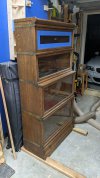 PXL_20220212_001759370.jpg1.9 MB · Views: 281
PXL_20220212_001759370.jpg1.9 MB · Views: 281
Last edited:

